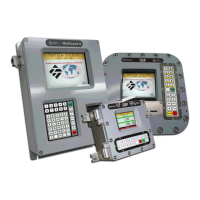Chapter 6 – Additive Control
Firmware Version 3/4.31.37
This parameter applies only to the Pulser additive method. Its purpose is to
compensate for the closing speed of the solenoid valve, which may allow consistent
over-deliveries. Compensation is accomplished on a pulse basis rather than a
volumetric basis. This feature is intended to eliminate the remaining over-delivery,
assuming mechanical adjustments to the solenoid valve's closing speed have already
been made. The quantity of pulse overruns due to valve action can be determined by
performing the additive calibration test. The quantity of excess pulses delivered for each
test injection can be observed. When the number of overrun pulses is determined, enter
the number into this parameter to eliminate the overrun.
Additive will stop delivery at the remaining preset quantity specified by this parameter.
Enter a numerical value in the units of volume used by the base components. When the
remaining quantity of the load reaches the volume specified in this parameter, delivery
of the selected additive will cease, regardless of the amount of additive demand that
remains. This is typically done to allow the additive to be flushed from the load arm by
the time product delivery is complete. If additive injection is desired throughout the
entire delivery, enter a zero for this parameter. See descriptions of the related
parameters entitled, Last Injection Volume From End and Line Flush Minimum Volume.
Last Injection Volume From End. This parameter specifies when the last injection
should occur, in order to deliver the proper additive volume, based on the preset
quantity. With the use of this parameter, it is possible to have the load arm flushed of
additive as described in the Shutoff Vol From End parameter, but still maintain a proper
additive/product ratio throughout most of the delivery. When the last injection is
initiated, the remaining additive requirement will be delivered as quickly as possible
before the Shutoff Volume From End volume is reached.
Example: We have a preset quantity of 1000 gallons and we want the additive to be
finished delivering by the time we reach the last 50 gallons of the batch, in order to flush
the load arm of additive. The Shutoff Vol From End parameter has been set to 50
gallons, commanding the additive to be finished by this point in the delivery. If we set
the Last Injection Volume From End parameter to 100 gallons, additive will be injected
at a rate that will ensure a proper additive ratio at any time before the last 100 gallons is
delivered. If the batch is aborted at the 500 gallon mark, the driver will have a properly
additized load. When the batch reaches the final 100 gallon mark, the system knows
that it has to have the remaining additive delivered before the final 50 gallon mark is
reached. The rate of injection is substantially increased to satisfy the requirement for
the load. As a result, the batch is over additized for a short time as the last 100 gallons
is delivered. When the last gallon has been delivered, the batch is properly additized.
Even if additive line flush is not a consideration, it is recommended that this parameter
be set to the default value of 20 gallons, which will ensure a precise delivery of additive.
Specifies the volume of product line flush that must occur to satisfactorily flush additive
from the load arm. Enter the value in the volumetric units used by the product flow
meter. After the additive has completed delivery, the volume entered in this parameter
must pass through the product flow meter. If the volume indicated in this parameter
does not get delivered after the additive requirement for the load has been met, an
additive flush alarm will occur. Enter a zero in this parameter to disable the feature. This
feature has no bearing on the settings of the flush parameters that are found in the
Preset menu.
If an additive is injected into a particular component of a sequential blend, all additive
volume for the batch must be delivered when this component is flowing. This
parameter, when non-zero, specifies that the additive can only flow when the specified
component is flowing.

